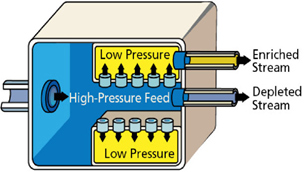Backgrounder on Uranium Enrichment (original) (raw)
On this page:
Nuclear power plants use uranium for fuel. One type of uranium atom – uranium-235 or U235 – is easily split to produce energy. U235 makes up less than 1 percent of natural uranium. To make fuel for reactors, this natural uranium is "enriched" to increase the U235 to between 3 and 5 percent.
The fuel cycle begins by mining and milling uranium ore into a powder. This powder is converted into a gas called uranium hexafluoride, or UF6. (In the United States, conversion is done at a Honeywell plant in Metropolis, Ill.) The UF6 contains both U235 and the more plentiful U238, which is heavier. This difference in weight allows the uranium to be enriched. In this process, the gas is separated into two streams—one with more U235 than before and the other with less. Today this is done by gas centrifuge. Until recently, gaseous diffusion was also used. A third method – laser enrichment – has been proposed for use in the United States
Gas Centrifuge
 |
|---|
| Schematic of a centrifuge |
The gas centrifuge process has been used in Europe for more than 40 years. It uses many rotating cylinders (centrifuges) that are connected in long lines. UF6 gas is placed in the cylinder, which spins at high speed, creating a strong centrifugal force. Heavier U238 gas molecules move to the cylinder wall, while lighter U235 collects near the center. The stream slightly enriched in U235 is fed into the next cylinder. The depleted stream is recycled back into the previous cylinder.
The NRC has licensed three gas centrifuge plants, though only one is currently operating. In 2006, Louisiana Energy Services (also known as Urenco USA) received a license to construct and operate the National Enrichment Facility in Eunice, N.M. This plant opened in 2010.
In 2004, the NRC licensed the United States Enrichment Corporation to construct and operate a demonstration and test facility known as the Lead Cascade in Piketon, Ohio. This test facility operated from 2007 to 2016 and was decommissioned in 2018. The NRC also licensed USEC in 2007 to build and operate the American Centrifuge Plant at Piketon. Now renamed as Centrus, the company proposes to construct and operate a 16-centrifuge operation in Piketon to produce High-Assay Low-Enriched Uranium, which would be enriched to between 5 and 20 percent U235. It would be used in fuel for new advanced reactor designs. The NRC is currently reviewing this proposal.
In 2011, the NRC issued a license to Areva Enrichment Services to construct and operate the Eagle Rock plant near Idaho Falls. In 2018, Areva rebranded as Orano and requested termination of the license. The NRC terminated the license in October 2018.
Gaseous Diffusion
 |
|---|
| Schematic of the gaseous diffusion process |
A gaseous diffusion plant processes UF6 in a vessel with small holes in its walls. A U235 molecule will travel faster and strike the walls more often than a molecule of U238, so more U235 flows through the walls. The gas that passes through the walls is enriched in the lighter isotope. The Department of Energy built two of these plants that eventually came under NRC oversight—in Piketon, Ohio, and Paducah, Ky. DOE turned the plants over to USEC, which Congress created as a government corporation in 1992 and privatized in 1996. The Ohio plant closed in 2001, the Kentucky plant in 2013.
Laser Enrichment
U235 can also be separated using specially tuned lasers. Lasers can increase the energy in the electrons of a specific isotope, changing its properties and allowing it to be separated. Laser enrichment is more technically complicated, but consumes less power and is more efficient. Two laser enrichment methods have been developed, but neither has been used commercially. DOE developed Atomic Vapor Laser Isotope Separation, or AVLIS, in the 1980s and 1990s. An Australian technology called SILEX, for Separation of Isotopes by Laser Excitation, is being developed by GE-Hitachi for potential use in the United States. The NRC licensed GE-Hitachi to construct and operate a test facility in Wilmington, N.C., in 2008 and a full commercial laser enrichment plant there in 2012. However, this project is on hold and construction has not begun.
NRC Responsibilities
Under the Atomic Energy Act, the NRC licenses and inspects uranium enrichment plants. Before issuing a license to construct and operate a plant, the NRC prepares an Environmental Impact Statement and a Safety Evaluation Report. The NRC gets public input on the issues to be addressed in the EIS through a process known as "scoping." Then the NRC prepares for public comment a draft EIS assessing what impact the facility might have on public health and the environment. Meanwhile, NRC experts review the application to make sure the proposed facility would meet the regulations. They document their findings in an SER. An independent licensing board examines the staff's work in a hearing. People who may be affected by the facility can raise safety or environmental concerns, which may be considered in a separate hearing.
No enrichment plant can operate until the NRC verifies through rigorous inspections that it has been constructed as required by the license. Throughout construction, NRC inspectors make sure the design, construction, installation and tests of the features that are important to safety comply with the license and NRC regulations. Inspectors also review policies and procedures to make sure the plant will be operated safely and securely.
As construction winds down, the NRC reviews the most safety-significant features. These include chemical safety, fire protection, radiation control, emergency preparedness, training and criticality safety. The NRC will only allow UF6 to be introduced after these inspections are completed. The inspections are conducted by experts from NRC headquarters in Maryland and the Region II office in Atlanta, which oversees fuel cycle facilities.
December 2020
Page Last Reviewed/Updated Thursday, January 07, 2021
